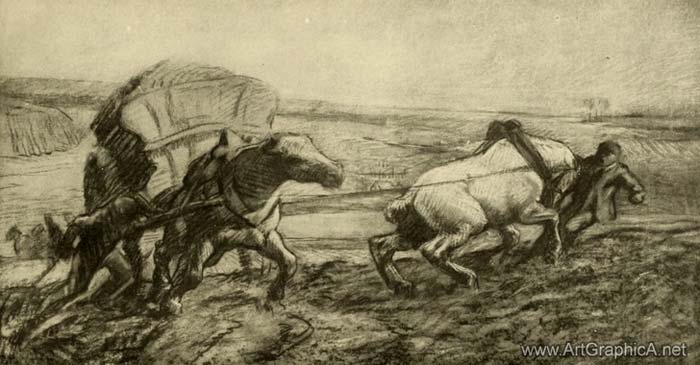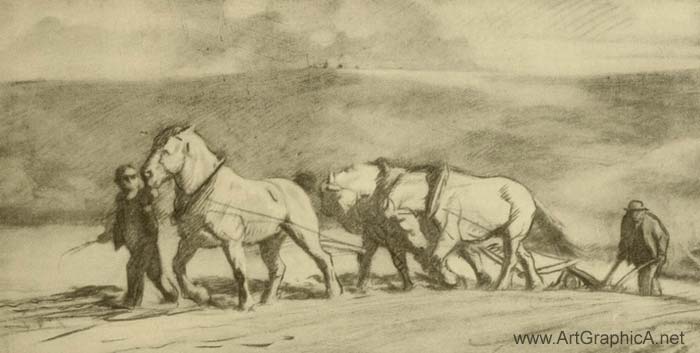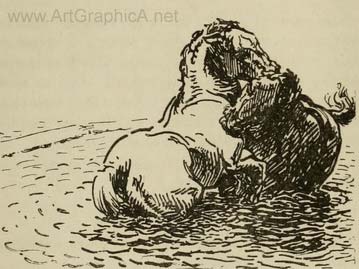Art and Rhythm, Horse Art |
|||||||||||||||||||||
|
Page 03 / 07
A NOTE ON THE DRAWING OF MOVEMENT ANYONE who has watched a greyhound running must feel that the undulations of the animal, with their rhythmic series and culminating accents, are comparable to the run and rhythm of an air in music, whereas a momentary phase of the movement, such as is recorded in an instantaneous photograph, resembles a detached chord, and, like it, has little meaning out of its context. Why is it that the instantaneous photograph almost invariably fails to capture any of this rhythmic sensation, or to recreate enjoyment such as is experienced in watching the greyhound run, whereas certain pictures successfully do so ? Is it not because our sense of movement is a subjective impression with which consequently the artist alone can deal ? While most people enjoy watching, shall we say, dancing, very few of them seem truly to be conscious of the source of their enjoyment. The majority appear to be unaware that their pleasure lies in following the visible music of motion, not in observing the dancers, who are only the instruments by which it is performed. As a result they are willing to accept as a picture of dancing a lifeless picture of dancers, which no more recalls the rhythms that were the essence of their pleasure than a picture of a violinist with his bow upon the strings revives the sounds that he was making. How then is the artist to capture this emanation, at once so real and so transitory ? Perception of movement is the result of combining mentally a series of separate impressions. In consequence our perception of movement is a subjective impression, so that in making a drawing of a moving figure or object there can be no question of copying the movement, no question of accuracy in the ordinary sense in which it is applied to the drawing of objects at rest. This is a point of capital importance, although apparently very few people, even of those really interested in Art, have troubled to consider it.
If sensation did not endure after the stimulus that created it has ceased, we should be incapable of perceiving change, and we should be sensible only of the impression of the actual moment, disconnected from all that comes before or after, seeing, like the photographic plate, only the separate attitudes of which the movement is composed, and never receiving the generalized impression which means seeing movement. Our perception of movement, then, is created by an act of recollection and is dependent on memory. Consequently it can only be drawn from recollection. In this the drawing of movement differs essentially from other forms of memory work. Artists, of course, constantly work from memory when dealing with fugitive effects of light, colour, grouping. They do so because such effects, though stationary, are of such brief duration that they do not allow sufficient time in which to record them on the spot. A group of figures, for instance, if only it would remain unaltered for a considerable length of time, could be painted directly, as the still-life painter paints his subjects, but the artist knows from experience that the group may at any moment be broken up by the movement of the individuals that compose it, so that he may think it wiser, instead of spending any of the precious seconds on the act of drawing, to devote them all to observing and storing up an impression from which he can work later. 
In such a case, to work from memory is merely the most practical way of working, whereas in the case of drawing movement the artist must work from memory, because he has no choice. For the movement which was the subject that roused his interest is only perceived as an idea formed in his mind out of impressions of phenomena which have already disappeared ; just as the idea of an air in music is formed of impressions preserved of sounds that are no longer heard. His subject, then, is not like a fugitive effect, which, however short its duration, is in principle stationary, being formed of parts simultaneously present, and so simultaneously to be observed. For his subject is an idea formed of impressions of successive phases which cannot be received simultaneously, and consequently can only be combined through recollection. Instantaneous photography is to many people a great obstacle to the proper understanding of how we perceive movement and what is involved in expressing it. The camera analyses and records for us passing phases of action which the eye cannot perceive, but which can be proved to occur ; and being an unemotional machine free from the frailties of excitable human beings such as artists, in general opinion it " cannot lie." Many people therefore prefer what the camera offers them to what they are offered by their own senses, and in time even come to believe that they ought to see as the camera sees. This is manifestly wrong, for, as has already been said, the camera cannot record movement. It never sees it. It arrests the effect of a moment, selecting instantaneous aspects only, thus producing a stationary condition which is the negation of movement itself.  TOURNANT LE TOMBEREAU. Horse art, drawing. " But photography does produce a vivid sense of movement," the reader will perhaps exclaim. " Look at the cinematograph ! " Exactly -- the cinematograph is the best proof of the camera's incapacity. For since a single photograph cannot, like a drawing, express movement of itself, the cinematograph is compelled to use them by hundreds, projecting their images in rapid sequence on the screen so that the eye may actually follow their variations across its surface through a period of time. The cinematograph does not attempt to summarize impressions of movement as the artist must. It expresses like by like, creating a fresh series of varying impressions which are reminiscent of the original impressions of the living scene from which the films were taken, reviving in their sequence the actual rhythms, obscurities, indefiniteness, distortions and emphasis of certain things which we should have seen for ourselves in nature. For if properly controlled it hides the camera's records of the stiff momentary attitudes invisible to us through which the limbs of the dancer or the greyhound pass, by merging them in the graceful rhythms which result therefrom, just as in nature the actual attitudes are hidden in the grace of the dancer and the greyhound.  PLOUGHING NEAR SALISBURY. Horse art, drawing. Art cannot use movement to represent movement. It has to render it in the fixed and unchanging materials in which the painter or the sculptor works, and in which indeed lies his strength. For the artist's purpose is not to reconstruct nature, but to communicate his own emotion and interest to others, whether his art be realistic and imitative or an abstraction not recognizably connected with natural appearance.
Next Page
Prev PageMovement and Direction Drawing Horses
|
|||||||||||||||||||||
 Movement implies change, and our perception of movement depends upon noting and comparing changes of shape, tone or colour in a series of visual impressions, just as our sense of music depends upon the comparison of a series of momentary sounds.
Movement implies change, and our perception of movement depends upon noting and comparing changes of shape, tone or colour in a series of visual impressions, just as our sense of music depends upon the comparison of a series of momentary sounds.







